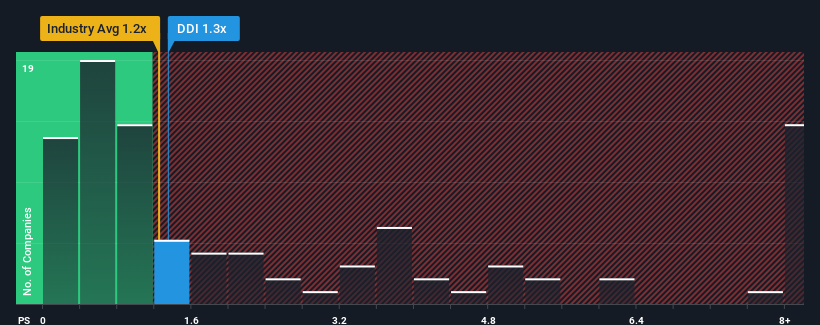- United States
- /
- Entertainment
- /
- NasdaqGS:DDI
DoubleDown Interactive Co., Ltd.'s (NASDAQ:DDI) Share Price Could Signal Some Risk
With a median price-to-sales (or "P/S") ratio of close to 1.2x in the Entertainment industry in the United States, you could be forgiven for feeling indifferent about DoubleDown Interactive Co., Ltd.'s (NASDAQ:DDI) P/S ratio of 1.3x. While this might not raise any eyebrows, if the P/S ratio is not justified investors could be missing out on a potential opportunity or ignoring looming disappointment.
See our latest analysis for DoubleDown Interactive

How DoubleDown Interactive Has Been Performing
DoubleDown Interactive could be doing better as its revenue has been going backwards lately while most other companies have been seeing positive revenue growth. It might be that many expect the dour revenue performance to strengthen positively, which has kept the P/S from falling. However, if this isn't the case, investors might get caught out paying too much for the stock.
Want the full picture on analyst estimates for the company? Then our free report on DoubleDown Interactive will help you uncover what's on the horizon.Is There Some Revenue Growth Forecasted For DoubleDown Interactive?
There's an inherent assumption that a company should be matching the industry for P/S ratios like DoubleDown Interactive's to be considered reasonable.
Taking a look back first, the company's revenue growth last year wasn't something to get excited about as it posted a disappointing decline of 8.8%. This means it has also seen a slide in revenue over the longer-term as revenue is down 10% in total over the last three years. So unfortunately, we have to acknowledge that the company has not done a great job of growing revenue over that time.
Looking ahead now, revenue is anticipated to climb by 5.4% during the coming year according to the two analysts following the company. With the industry predicted to deliver 13% growth, the company is positioned for a weaker revenue result.
In light of this, it's curious that DoubleDown Interactive's P/S sits in line with the majority of other companies. It seems most investors are ignoring the fairly limited growth expectations and are willing to pay up for exposure to the stock. These shareholders may be setting themselves up for future disappointment if the P/S falls to levels more in line with the growth outlook.
The Bottom Line On DoubleDown Interactive's P/S
It's argued the price-to-sales ratio is an inferior measure of value within certain industries, but it can be a powerful business sentiment indicator.
Our look at the analysts forecasts of DoubleDown Interactive's revenue prospects has shown that its inferior revenue outlook isn't negatively impacting its P/S as much as we would have predicted. When we see companies with a relatively weaker revenue outlook compared to the industry, we suspect the share price is at risk of declining, sending the moderate P/S lower. A positive change is needed in order to justify the current price-to-sales ratio.
Many other vital risk factors can be found on the company's balance sheet. You can assess many of the main risks through our free balance sheet analysis for DoubleDown Interactive with six simple checks.
If companies with solid past earnings growth is up your alley, you may wish to see this free collection of other companies with strong earnings growth and low P/E ratios.
New: Manage All Your Stock Portfolios in One Place
We've created the ultimate portfolio companion for stock investors, and it's free.
• Connect an unlimited number of Portfolios and see your total in one currency
• Be alerted to new Warning Signs or Risks via email or mobile
• Track the Fair Value of your stocks
Have feedback on this article? Concerned about the content? Get in touch with us directly. Alternatively, email editorial-team (at) simplywallst.com.
This article by Simply Wall St is general in nature. We provide commentary based on historical data and analyst forecasts only using an unbiased methodology and our articles are not intended to be financial advice. It does not constitute a recommendation to buy or sell any stock, and does not take account of your objectives, or your financial situation. We aim to bring you long-term focused analysis driven by fundamental data. Note that our analysis may not factor in the latest price-sensitive company announcements or qualitative material. Simply Wall St has no position in any stocks mentioned.
About NasdaqGS:DDI
DoubleDown Interactive
Engages in the development and publishing of casual games and mobile applications in South Korea.
Very undervalued with flawless balance sheet.
Similar Companies
Market Insights
Community Narratives



